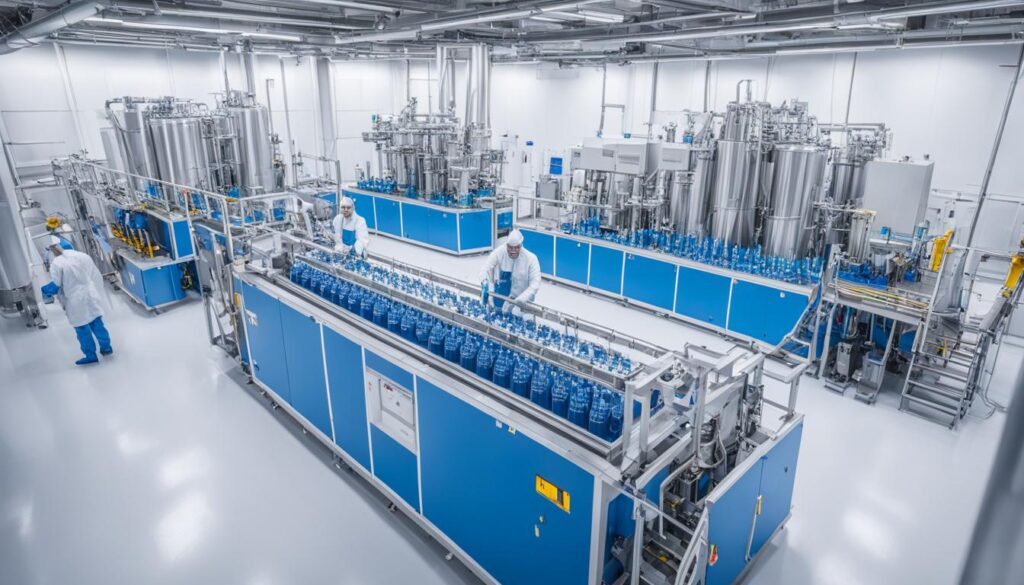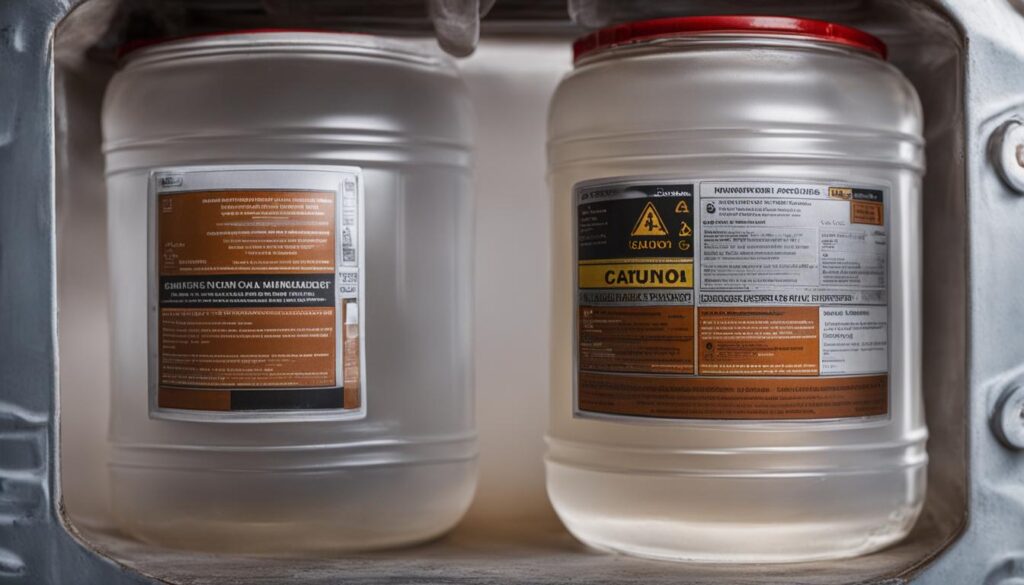Sodium hydroxide, also known as caustic soda, is a versatile substance that has a wide range of uses and benefits across various industries. Its chemical formula, NaOH, indicates its composition as a strong alkali, making it an essential component in many industrial processes.
From pharmaceuticals to energy production, sodium hydroxide plays a crucial role in numerous applications. Its properties and versatility make it a valuable resource in different sectors, contributing to the development of various products and technologies.
Key Takeaways:
- Sodium hydroxide is used in the manufacturing of medicines, fuel cells, and water treatment processes.
- It is a key ingredient in cleaning products, such as drain cleaners and oven cleaners, due to its strong cleaning properties.
- The pharmaceutical industry utilizes sodium hydroxide in the production of pain relievers and anticoagulants.
- Sodium hydroxide contributes to clean and efficient electricity generation through its use in fuel cell production.
- It is widely employed in water treatment facilities to control acidity and remove heavy metals, ensuring clean and safe drinking water.
Sodium Hydroxide in Cleaning

Sodium hydroxide, commonly known as caustic soda, is a versatile chemical compound widely used in the cleaning industry. Its strong alkaline properties make it an excellent ingredient in soaps, detergents, and various cleaning products. Sodium hydroxide’s effectiveness in tackling tough stains, grease, and grime has made it a popular choice for both domestic and commercial cleaning purposes.
Drain Cleaners:
Sodium hydroxide plays a vital role in the production of drain cleaners. These cleaners are specifically formulated to dissolve clogs and blockages in pipes and drains. It achieves this by converting fats, oils, and grease into soap through a process called saponification. The soap then allows for the easy dissolution of these substances, restoring the flow of wastewater.
Oven Cleaners:
In addition to drain cleaners, sodium hydroxide is also a key ingredient in oven cleaners. Oven surfaces often accumulate stubborn grease, grime, and food residues that can be challenging to remove. Sodium hydroxide’s powerful cleaning properties help break down these tough deposits, making oven cleaning more efficient and convenient.
“Sodium hydroxide’s strong cleaning properties make it effective in eliminating stubborn stains and grease buildup.”
Whether you’re tackling a clogged drain or dealing with a grimy oven, cleaning products containing sodium hydroxide can be a reliable solution. Its ability to dissolve fats and grease, coupled with its robust cleaning properties, ensures effective and thorough cleaning results.
Benefits of Sodium Hydroxide in Cleaning:
- Effective in removing tough stains and grease buildup
- Helps dissolve clogs and blockages in pipes and drains
- Convenient solution for cleaning ovens and other greasy surfaces
- Ensures thorough and efficient cleaning
- Widely used in both domestic and commercial cleaning products
| Cleaning Product | Description |
|---|---|
| Drain Cleaners | Converts fats, oils, and grease into soap, allowing for the dissolution of clogs in pipes and drains. |
| Oven Cleaners | Utilizes sodium hydroxide to break down tough stains, grease, and grime on oven surfaces. |
Sodium Hydroxide in Pharmaceuticals and Medicine

Sodium hydroxide, a versatile chemical compound, finds extensive application in the manufacturing of various medicines and pharmaceutical products. Its inclusion in the pharmaceutical industry highlights its importance in the healthcare sector.
One notable application of sodium hydroxide is in the production of common pain relievers, such as aspirin. By participating in the synthesis process, sodium hydroxide ensures the production of effective pain-relieving medications.
Additionally, sodium hydroxide plays a crucial role in the manufacturing of anticoagulants, which help prevent blood clots. These medications are vital in reducing the risk of thrombosis and managing various cardiovascular conditions.
Sodium hydroxide is also utilized in cholesterol-reducing medications. By contributing to the synthesis of these drugs, it aids in managing cholesterol levels and promoting cardiovascular health.
It is noteworthy to mention that the role of sodium hydroxide in pharmaceuticals extends beyond these examples, with its applications reaching different areas of medicine. Its versatility and contribution to the production of essential medications make it a crucial component of the pharmaceutical industry.
| Medication Type | Application |
|---|---|
| Pain Relievers | Production of common analgesics like aspirin |
| Anticoagulants | Prevention of blood clots |
| Cholesterol-Reducing Medications | Management of cholesterol levels |
Sodium Hydroxide in Energy

Sodium hydroxide plays a crucial role in the production of clean and efficient electricity. One of its major applications in the energy sector is in fuel cell production. Fuel cells powered by sodium hydroxide offer a sustainable and reliable source of power for various applications.
Fuel cells have the potential to revolutionize transportation by providing an alternative to fossil fuels. Sodium hydroxide is used in fuel cell membranes, which facilitate the conversion of chemical energy into electrical energy without combustion, resulting in reduced emissions and improved air quality.
Fuel cells powered by sodium hydroxide can also be utilized in materials handling equipment, such as forklifts, where they provide a cost-effective and environmentally friendly solution. These fuel cells eliminate the need for traditional batteries, reducing downtime and improving efficiency.
The versatility of sodium hydroxide in fuel cell production extends to stationary, portable, and emergency backup power sources. Sodium hydroxide-based fuel cells have been used to provide uninterrupted power supply during natural disasters or in remote areas with limited access to electricity.
“Fuel cells powered by sodium hydroxide offer a sustainable and reliable source of power for various applications.”
In addition to fuel cells, sodium hydroxide also has a role in the production of epoxy resins used in wind turbines. These resins help provide structural strength and durability to wind turbine blades, ensuring efficient energy generation from the wind. Sodium hydroxide’s involvement in the production of epoxy resins contributes to the advancement of sustainable energy solutions.
The table below highlights the key applications of sodium hydroxide in energy:
| Application | Benefits |
|---|---|
| Fuel cell production | Clean and efficient electricity generation for transportation and stationary power |
| Materials handling | Cost-effective and environmentally friendly alternative to traditional batteries |
| Emergency backup power | Uninterrupted power supply during natural disasters and in remote areas |
| Epoxy resin production | Enhanced structural strength and durability for wind turbine blades |
As the demand for clean and sustainable energy sources continues to grow, sodium hydroxide will play a vital role in fuel cell production and other energy applications.
Sodium Hydroxide in Water Treatment

Sodium hydroxide plays a crucial role in water treatment, particularly in municipal water treatment facilities. Its many applications help to improve the quality of drinking water and ensure its safety for consumption.
One significant use of sodium hydroxide in water treatment is its ability to control water acidity. By adjusting the pH levels, sodium hydroxide helps to neutralize acidic water, making it more suitable for consumption. This process is essential in reducing the corrosiveness of water, protecting the infrastructure in water distribution systems.
In addition to controlling acidity, sodium hydroxide is also employed to remove heavy metals from water. Heavy metals, such as lead, mercury, and arsenic, can contaminate water sources and pose health risks when consumed. Sodium hydroxide reacts with these metals, forming precipitates that can be easily removed through filtration processes, ensuring safer drinking water.
An important byproduct of sodium hydroxide use in water treatment is the production of sodium hypochlorite. Sodium hypochlorite is a powerful water disinfectant commonly used to kill bacteria, viruses, and other harmful microorganisms present in water sources. It plays a pivotal role in preventing waterborne diseases and maintaining clean and safe water supplies.
The Role of Sodium Hydroxide in Municipal Water Treatment:
| Application | Description |
|---|---|
| Water Acidity Control | Adjusting pH levels to neutralize acidic water, reducing corrosiveness. |
| Heavy Metal Removal | Reacting with heavy metals and facilitating their removal from water sources. |
| Sodium Hypochlorite Production | Producing a water disinfectant to eliminate harmful microorganisms. |
Sodium hydroxide’s vital role in water treatment underscores its significance in safeguarding public health and ensuring the provision of clean and safe water to communities.
Sodium Hydroxide in Food Production

Sodium hydroxide, with its versatile properties, plays a crucial role in various food production processes. Its applications in food processing contribute to the preservation, quality, and safety of processed foods.
One notable use of sodium hydroxide is in the curing of foods, such as olives. The chemical reaction between sodium hydroxide and the natural acidity of olives helps reduce their bitterness and enhances their flavor. Additionally, sodium hydroxide is involved in the browning of pretzels, giving them their distinctive golden-brown crust.
Furthermore, sodium hydroxide is commonly used to remove the skins from fruits and vegetables during the canning process. This helps improve the texture and appearance of canned products, ensuring a pleasant consumer experience. The chemical reaction between sodium hydroxide and the skin breaks down the bonds, making it easier to peel fruits and vegetables.
In addition to its physical effects, sodium hydroxide acts as an essential ingredient in food preservatives. It prevents the growth of mold and bacteria in processed foods, helping to extend their shelf life and maintain their quality and safety.
Considering the significance of sodium hydroxide in food production, it is essential to ensure its careful and proper usage. Adhering to industry regulations, food manufacturers implement stringent quality control measures, including accurate dosing and efficient mixing during the incorporation of sodium hydroxide in food processing.
Overall, sodium hydroxide’s involvement in food production processes underscores its importance in the food industry, contributing to the development of a wide range of processed foods with improved flavor, texture, and shelf life.
Sodium Hydroxide in Wood and Paper Products

Sodium hydroxide plays a significant role in the production of wood and paper products, contributing to their quality and versatility. In the paper making process, sodium hydroxide is utilized to treat wood and remove unwanted materials, including lignin and hemicellulose. This treatment ensures that only pure cellulose remains, which is crucial for the production of high-quality paper. By removing impurities, sodium hydroxide enhances the strength and durability of the resulting paper, making it suitable for various applications.
Moreover, sodium hydroxide plays a vital role in the recycling of paper. During the recycling process, sodium hydroxide is used to remove ink from the paper fibers, allowing for the reuse of these fibers. This helps to conserve resources and reduce waste in the paper industry.
Furthermore, sodium hydroxide finds application in wood bleaching, cleaning, and refining processes for wood products such as cabinets and furniture. It is used to brighten wood surfaces, removing stains and discoloration. Sodium hydroxide also assists in cleaning and refining wood, ensuring that the final products meet high standards of quality and aesthetics.
In conclusion, sodium hydroxide plays a vital role in the production of wood and paper products. Its involvement in the paper-making process and recycling industry ensures the production of high-quality paper while minimizing waste. Additionally, sodium hydroxide’s application in wood bleaching, cleaning, and refining processes enhances the appearance and durability of wood products.
Sodium Hydroxide in Aluminum Ore Processing
Sodium hydroxide plays a crucial role in the extraction of alumina from naturally occurring minerals. Alumina is a key ingredient used in the production of aluminum and various aluminum products, such as foil, cans, kitchen utensils, and airplane parts. The use of sodium hydroxide in aluminum ore processing is vital for the creation of materials that are widely utilized in construction and other industries.
| Benefits of Sodium Hydroxide in Aluminum Ore Processing |
|---|
| Facilitates the removal of impurities from aluminum ore |
| Aids in the separation and extraction of alumina |
| Enables the production of high-quality alumina for aluminum production |
| Contributes to the manufacturing of various aluminum products |
The extraction process begins with the treatment of aluminum ore with sodium hydroxide. This chemical reacts with impurities present in the ore, allowing for their removal and purification of the desired alumina compound. The purified alumina is then used as a feedstock in the production of aluminum, where it undergoes electrolysis to obtain the final metal product.
The use of sodium hydroxide in aluminum ore processing not only ensures the production of high-quality alumina but also contributes to sustainable manufacturing practices. Aluminum is lightweight, durable, and highly recyclable, making it an eco-friendly alternative to other materials in various applications.
By harnessing the power of sodium hydroxide in aluminum ore processing, industries can efficiently produce aluminum and its derivatives, meeting the demands of modern construction, aerospace, packaging, and transportation sectors.
Sodium Hydroxide in Other Industrial Manufacturing Uses

Sodium hydroxide, commonly known as caustic soda, is a versatile chemical compound with various applications in industrial manufacturing processes. Its alkaline properties make it an essential component in numerous industries, including textiles, explosives, epoxy resins, paints, glass, ceramics, and metal processing.
The textile industry extensively utilizes sodium hydroxide in various stages of fabric production. It plays a crucial role in dye production, cotton fabric processing, laundering, and bleaching. Sodium hydroxide helps in removing impurities, enhancing the quality, and ensuring vibrant and lasting colorfastness in textiles.
“Sodium hydroxide is an indispensable component in the textile industry, contributing to the production of high-quality and visually appealing fabrics.”
Industrial Manufacturing Applications
Sodium hydroxide’s versatility also extends to other manufacturing processes:
- Rayon and spandex production: Sodium hydroxide is involved in the manufacturing of synthetic fibers like rayon and spandex. It assists in the dissolution and regeneration of cellulose or protein polymers, creating fibers with desirable properties.
- Epoxy resins: Sodium hydroxide acts as a catalyst in the production of epoxy resins, which find applications in coatings, adhesives, and composites. Epoxy resins offer excellent mechanical strength and corrosion resistance.
- Explosives: Sodium hydroxide plays a role in manufacturing certain types of explosives, such as nitroglycerin. It helps stabilize explosive compounds while ensuring the desired reactivity and safety.
- Paints: Sodium hydroxide is used in the production of water-based paints. It helps adjust the pH level and enhances the stability and characteristics of the paint formulations.
- Glass and ceramics: Sodium hydroxide is used as a fluxing agent in glass and ceramic production processes. It lowers the melting point of these materials, allowing for easier manipulation and shaping.
- Metal cleaning and processing: Sodium hydroxide is employed in metal cleaning and processing industries. It helps remove rust, grease, and other contaminants, preparing metal surfaces for further treatment or coating.
- Oxide coating, electroplating, and electrolytic extraction: Sodium hydroxide is utilized in various surface treatments, including oxide coating, electroplating, and electrolytic extraction. It facilitates the creation of protective coatings, enhances surface finishes, and aids in metal extraction processes.
Throughout these industrial applications, sodium hydroxide’s powerful alkaline properties make it an invaluable chemical in terms of facilitating reactions, balancing pH levels, and ensuring optimal performance in manufacturing processes.
| Industrial Application | Function of Sodium Hydroxide |
|---|---|
| Textile industry | Dye production, fabric processing, laundering, and bleaching |
| Rayon and spandex production | Dissolution and regeneration of cellulose or protein polymers |
| Epoxy resins | Catalyst in the production of epoxy resins for coatings and adhesives |
| Explosives | Stabilization and reactivity control in explosive compounds |
| Paints | pH adjustment and stability enhancement in water-based paints |
| Glass and ceramics | Fluxing agent for lowering melting points of glass and ceramics |
| Metal cleaning and processing | Removal of rust, grease, and contaminants from metal surfaces |
| Oxide coating, electroplating, and electrolytic extraction | Creation of coatings, surface finishing, and metals extraction |
Sodium Hydroxide Safety Precautions and Storage
When it comes to handling sodium hydroxide, safety precautions are paramount. In industries where sodium hydroxide is used, workers must be well-versed in following OSHA guidelines and staying within permissible exposure limits. Protecting oneself while working with sodium hydroxide is essential to prevent any potential hazards.
Proper storage of sodium hydroxide is equally important. It should be stored in tightly closed containers in a cool and well-ventilated area. It is crucial to keep sodium hydroxide away from water and moisture to prevent any unwanted reactions. Adequate labeling and segregation of storage areas are necessary to ensure the safety and integrity of the chemical.
In the event of spills or emergencies involving sodium hydroxide, it is crucial to have proper training and equipment for clean-up. Quick response and appropriate safety measures can minimize the impact of such incidents. Additionally, it is essential to take precautions to avoid any reactions with other substances, as sodium hydroxide can be reactive under certain conditions.
By following the recommended safety procedures, workers can ensure the safe handling and storage of sodium hydroxide, mitigating the risks associated with its use. Adherence to these precautions is crucial to protect both the individual and the environment from any potential harm.
FAQ
What are the uses and benefits of sodium hydroxide?
Sodium hydroxide is a versatile substance used in various industries and applications. It is used in the manufacturing of medicines, including aspirin and anticoagulants. It is also used in fuel cell production for clean and efficient electricity generation. Sodium hydroxide is utilized in the production of sodium hypochlorite, a water disinfectant. Additionally, this chemical is used in the manufacturing of paper, aluminum, cleaning products, soaps and detergents, as well as in food processing, wood products, and various industrial processes.
How is sodium hydroxide used in cleaning?
Sodium hydroxide is commonly used in the production of soaps, detergents, and cleaning products. It is a key ingredient in drain cleaners, which convert fats and grease into soap, allowing for the dissolution of clogs in pipes. Sodium hydroxide is also used in oven cleaners to remove tough grease and grime. Its strong cleaning properties make it effective in eliminating stubborn stains and grease buildup.
What are the pharmaceutical and medical uses of sodium hydroxide?
Sodium hydroxide plays a role in the manufacturing of various medicines and pharmaceutical products. It is used in the production of common pain relievers like aspirin, as well as anticoagulants that help prevent blood clots. Additionally, sodium hydroxide is used in cholesterol-reducing medications. Its application in the pharmaceutical industry highlights its importance in the healthcare sector.
How does sodium hydroxide contribute to energy production?
Sodium hydroxide is utilized in fuel cell production, making it essential for clean and efficient electricity generation. Fuel cells powered by sodium hydroxide can be used in transportation, materials handling, and as stationary, portable, and emergency backup power sources. It also has a role in the production of epoxy resins used in wind turbines, contributing to sustainable energy solutions.
What is the role of sodium hydroxide in water treatment?
Sodium hydroxide is employed in municipal water treatment facilities to control water acidity and remove heavy metals. It helps to improve the quality of drinking water and ensure its safety. Sodium hydroxide is also used in the production of sodium hypochlorite, a water disinfectant commonly used for water treatment. Its role in water treatment highlights its importance in maintaining clean and safe water supplies.
How is sodium hydroxide used in food production?
Sodium hydroxide finds applications in various food processing activities. It is used for curing foods like olives and browning pretzels. Sodium hydroxide is also used to remove the skins from tomatoes, potatoes, and other fruits and vegetables for canning. Additionally, it acts as an ingredient in food preservatives, preventing the growth of mold and bacteria. Its usage in food production contributes to the preservation and quality of processed foods.
How is sodium hydroxide involved in the production of wood and paper products?
Sodium hydroxide is used in the production of wood and paper products. In paper making, it is used to treat wood and remove unwanted materials, leaving behind pure cellulose for paper production. Sodium hydroxide is also used in the recycling process to remove ink from paper fibers, allowing for the reuse of these fibers. Additionally, it is used in wood bleaching, cleaning, and refining processes for wood products such as cabinets and furniture.
What is the role of sodium hydroxide in aluminum ore processing?
Sodium hydroxide plays a crucial role in the extraction of alumina from naturally occurring minerals. Alumina is used in the production of aluminum and various aluminum products, including foil, cans, kitchen utensils, and airplane parts. The use of sodium hydroxide in aluminum ore processing contributes to the production of materials used in construction and other industries.
In what other industrial manufacturing processes is sodium hydroxide used?
Sodium hydroxide finds applications in numerous other industrial and manufacturing processes. It is used in the manufacturing of rayon, spandex, explosives, epoxy resins, paints, glass, and ceramics. The textile industry utilizes sodium hydroxide for dye production, cotton fabric processing, laundering, and bleaching. It is also used in metal cleaning and processing, oxide coating, electroplating, and electrolytic extraction. Its versatility makes it a valuable component in various industrial manufacturing processes.
What safety precautions should be taken when handling sodium hydroxide?
While sodium hydroxide has numerous uses and benefits, it is important to handle it with safety precautions. Workers in industries where sodium hydroxide is used must adhere to OSHA guidelines and permissible exposure limits. It is essential to store sodium hydroxide properly in tightly closed containers in a cool, well-ventilated area away from water and moisture. Spills and emergencies require proper training and equipment for clean-up, and certain precautions must be taken to prevent reactions with other substances. Following safety procedures ensures the safe handling and storage of sodium hydroxide.






